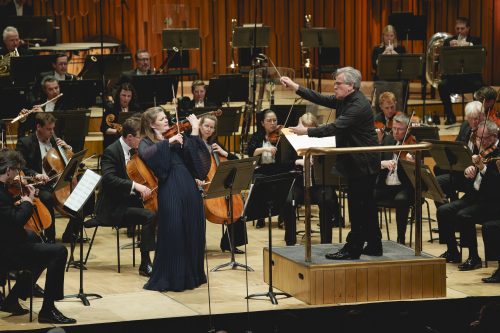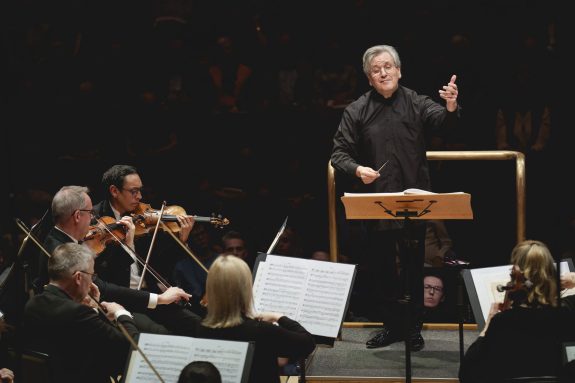 United Kingdom L. Boulanger, Barber, Rachmaninov: Janine Jansen (violin), London Symphony Orchestra / Sir Antonio Pappano (conductor). Barbican Hall, London, 14.4.2024. (JR)
United Kingdom L. Boulanger, Barber, Rachmaninov: Janine Jansen (violin), London Symphony Orchestra / Sir Antonio Pappano (conductor). Barbican Hall, London, 14.4.2024. (JR)

L. Boulanger – D’un matin de printemps
Barber – Violin Concerto, Op.14
Rachmaninov – Symphony No.2, Op.27
Underestimated but certainly gifted Marie-Juliette Olga ‘Lili’ Boulanger was the first female winner of the Prix de Rome composition prize. She was the younger sister of noted composer and composition teacher Nadia. Sadly, Lili died at the tender age of 24, of complications following bronchial pneumonia. In the final months of her life, she conjured up the sounds of a spring morning from her sickbed. The instruction in the score is ‘quite lively, light, cheerful’ and that is exactly how it came across, Antonio Pappano conducting with both incredible levity and animation. The piece is full of energy, with propulsive pulsing alternating with some sparkle (from triangle and celeste). The piece is only five minutes long, very impressionist in style and left one wondering what she would have gone on to compose had she not met an untimely end.
Samuel Barber is best known, of course, for his Adagio for Strings, but his easy-going Violin Concerto probably comes second in terms of popularity. Composed in 1939, Barber rejected the ways of the Second Viennese School led by Arnold Schoenberg, and also Stravinsky’s new levels of spiky dissonance, to follow his own less aggressive path, linked to the dying strains of Romanticism and adding a distinctly American flavour. This might explain his relative neglect, certainly on this side of the Pond, from the twentieth-century classical music canon.
His Violin Concerto makes for easy listening: playful, folk-like passages are intermingled with passionate outbursts, Janine Jansen perfectly attuned to the first movement’s predominantly serene mood. In the wistful ardent Adagio, Jansen’s limelight was almost stolen by Julianne Koch’s sublime solo oboe playing. Ending with an invigorating moto perpetuo finale, this lovely work allowed Jansen to showcase all her prodigious virtuosic talents, aided by the warmth, richness and bloom of her fine instrument. Pappano accompanied with a full-blooded orchestral contribution. Pappano, former pianist and répétiteur, then sprung a surprise: he emerged with sheet music in hand to accompany Jansen at the piano for the encore, a charming miniature by Lili Boulanger (‘Nocturne’ from Deux morceaux pour violon et piano) in the style of a tea dance.
Jansen is currently Artist-in-Residence at the Wigmore Hall. She will return to the London Symphony Orchestra in June for Sally Beamish’s Double Concerto for clarinet and violin (Distans) together with Martin Fröst. Her latest recording, 12 Stradivari, is a unique exploration of twelve great Stradivarius violins and the repertoire these instruments inspired. For this concert, she played her (loaned) Shumsky-Rode Strad from 1715.

Rachmaninov’s Second Symphony is widely regarded as the finest of his three symphonies and it has rightly become one of his most popular works. His other two symphonies have some very fine passages and themes, but, to my mind, they fail to gel in the same way as his second. The symphony is full of fire and passion and Pappano did not stint for a moment, and never allowed any part of the symphony to drag. The orchestra followed his every small instruction. Pappano had augmented the string section to give the strings a full, warm bloom; the brass were secure and well-blended and percussion crisp and forthright – the LSO at its very best; at this level clearly vying to be recognised as London’s top world-class orchestra. Pappano knows exactly how to unleash the orchestra’s full sound; he was always in command of the composer’s effulgent, lush sweep of the melodic line. The strings were at their finest in the contrapuntal scampering section of the Adagio. In the third movement, it was Sérgio Pires’s fine solo clarinet solo which caught the ear. The fourth movement reminded me how central bells were to Rachmaninov’s musical development; one heard the chimes in both the strings and percussion. This boisterous movement (Allegro vivace), with its thunderous climax, ended the concert and received a deservedly huge roar from a thoroughly delighted audience.
John Rhodes
